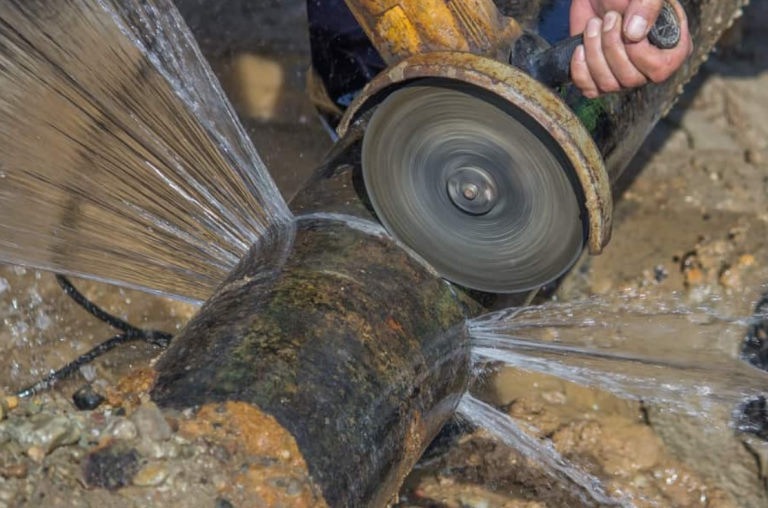If you live in an old house, cast iron is likely used to make up its plumbing system, which means you’ll inevitably have to deal with leakage. Fortunately, it’s simple to fix the problem yourself at home.
This article will focus on how to cut cast iron pipe with an angle grinder, which is one of the power tool options that can help you fix the leaks in your house’s pipe system.
Contents
Can I Use An Angle Grinder To Cut Cast Iron Pipes?
Angle grinders can cut pipes made of cast iron, but not all of them will work. The inexpensive, low-quality one is an example, as its power will be too weak to penetrate this type of tough material. If you need a smooth and efficient performance for this job, consider buying a high-quality tool.
An angle grinder has a circular attachment linked to its head which is called a “disc”, “wheel”, or “blade” if thicker than 0.5 inch. There are various types of angle grinder discs, and each of them handles a different task (cut, grind, polish, smooth, sharpen, etc) as well as different materials (concrete, masonry, brick, ferrous & non-ferrous metal, wood, etc).
So, as long as you have a high-quality grinder and a proper disc for cutting cast iron, you can carry out this task efficiently.
How To Cut Cast Iron Pipes With An Angle Grinder?
First, for an easy start, you should place it on a workbench or keep it locked with riser clamps. Next, use the grinder and cut a groove. The groove must be of uniform depth around the pipe. Then, let the grinder wheel penetrate into one specific point. Finally, cutting around this point to finish the process.
Here are 6 detailed steps to cut cast iron pipes by using an angle grinder.
Step 1. Wearing safety gear
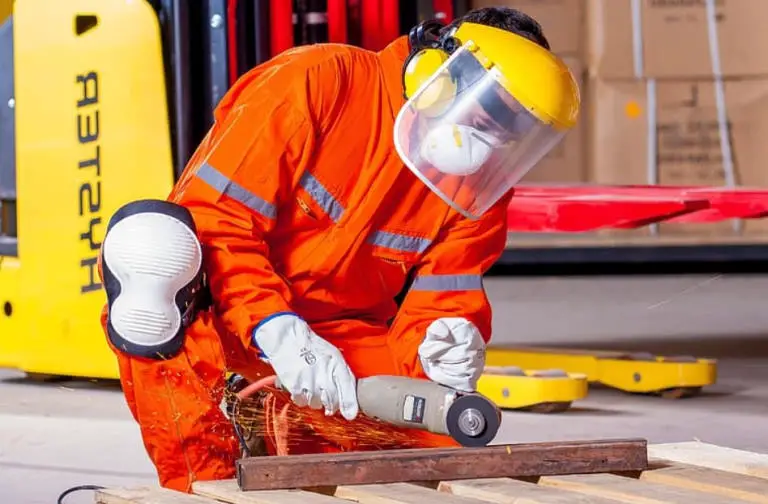
Because the grinder is fairly simple to use, many people forego safety precautions to complete their tasks as soon as possible, which is a big mistake. Grinders, like any power tool, can be hazardous if not used properly, particular when your project is cutting metal.
So, you should put on your personal protection equipment at all times to avoid accidents and injuries. The following items should be included in your comprehensive safety gear for cutting through pipes made of cast iron:
- Safety goggles: Protect your eye from risks such as sparks and debris.
- Earmuff: For your ear protection from the grinder’s deafening noise.
- A full-face shield: For avoiding breathing in any dust or gases emitted when cutting.
- Gloves: Help you grip more securely and protect your hands from wounds.
- Safety boots: Protect your feet from flying metal fragments after they have been cut.
- Tight-fitting clothing: Prevent fabric from being entangled in the grinding wheel.
If you have not already, we strongly advise you to read the owner’s manual of your angle grinder, since different models may require extra safety precautions.
Step 2. Prepare the workspace
First, you should clean up the workspace where you will carry out your cast iron cutting task. Pay careful attention to the workspace’s floor and any objects that can get tangled or stuck to the machine’s power cord, which will avoid any accidents, tripping, and falling.
Step 3. Prepare the grinder
The next step is to prepare your grinder before connecting it to a power supply.
Open the machine’s spindle and install the disc before tightening the spindle nut. Before operating, ensure that both the grinder and the disc are in good working order. Power up the machine and let it spin for around 30 seconds to make sure that everything is in place and working well.
Step 4. Make the pipes stable
After that, stabilize your workpiece, using either riser-clamps or pipe hangers. This is necessary as cutting unsupported workpieces, particularly when they are hefty like cast iron, is exceedingly perilous.
If the piece is a vertical pipe, you should stabilize it by using riser clamps at floor level to prevent it from falling after you have cut through it. For a horizontal pipe, use a pipe hanger for every 5 feet to increase support.
Step 5. Mark the cut sections
The final preparation step is to mark the cut sections. You can use chalk to draw the outline for your cutting on the black iron pipe. You must be extremely careful while doing this step. To get good and precise results, consider using a ruler.
This phase is critical since any errors in marking the cutting section would lead to both poor cutting results and the degradation of the cast iron pipe’s quality.
Note: Make sure that you have cut off the house’s water supply and the pipes you will work on are empty.
Step 6. Start cutting

Cutting cast iron pipes by an angle grinder might take you a more difficult time as they are frequently positioned in tight or difficult-to-reach locations. However, the cutting procedure is quite simple.
- Position the blade guard between your body and the tool.
- Allow the wheel to reach maximum speed after turning on the grinder to produce smoother and better results. This should only take a maximum of 1 minute.
- Securely grip the grinder using both hands, then set the disc down gently on your marked section while maintaining a 90-degree angle.
- Score an approximate ⅛ inch groove in depth which wraps around the pipe’s diameter.
- Once you have cut the groove, use the grinder to pierce the pipe at a single location and work your way around it till your cut is complete.
- Turn off your angle grinder and take a cold chisel. To snap the cut part off and remove the pipe segment, use a ball-peen hammer to cut through the remaining connecting point.
Guides On Choosing Cutting Disc For Cast Iron
The best blade to cut cast iron pipe is a diamond disc with a diameter of 4 inches. This kind of grinder disc has a core made of steel and a razor-sharp synthetic diamond edge, which is ideal for cutting through hard materials.
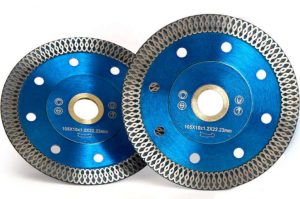
Here are 4 criteria to look for when selecting a proper disc for cutting cast iron:
The disc material
A grinder’s discs are constructed of abrasive material grains that are linked to each other thanks to a bonding agent. Each abrasive material is most suitable for different uses. For cutting a strong and fragile metal like cast iron, a grain disc made of silicon carbide is good to use.
The disc bond
The abrasive material of angle grinder wheels is held together by a bond. Soft-bond wheels become duller more rapidly than hard-bond counterparts but are more suitable for cutting through tough metals such as cast iron.
Their soft bond enables the shedding of worn abrasive material, which allows for the emergence of new, sharper edges that can cut through the hard workpiece.
The disc grit
Grit refers to the density of abrasive grains expressed as the number of grains that could travel through a given space. Smaller grains are represented by higher grit numbers, whereas larger ones are represented by lower grit numbers.
Ideally, you should use discs with a high grit to produce a clean and smooth finish. Low-grit discs cut faster, but they leave rough edges. To remove a segment of cast iron pipes, you should go for a low-grit disc.
The disc compatibility
The size and speed of the disc that you select for the task should be compatible with your grinder to avoid kickbacks and the danger of wheel failure.
So, make sure that the wheel’s maximum RPM is at least equivalent to your grinder’s number before operating on your workpiece.
How To Cut Cast Iron In Tight Places?
If your workspace is tight, you should not use an angle grinder because it generates a lot of sparks, which can be potentially dangerous. The alternatives are reciprocating saws and soil pipe cutters or snap cutters, which can offer necessary cuts without producing hazardous sparks.
Remember that you still need to make careful preparations and take necessary precautions before using these two tools.
Use reciprocating saws
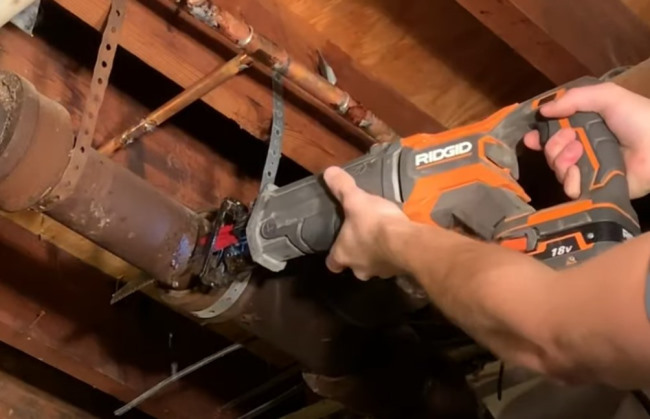
You can use either a diamond or a carbide-tipped disc for your reciprocating saw to cut cast iron but I prefer the latter.
- Lubricate the saw blade by spraying some WD-40 on the cast iron pipes, which also prevents it from wearing out.
- Assemble a carbide-tipped disc or a diamond wheel to the saw.
- To make a correct and clean cut, use a piece of chalk to mark the section of the pipe.
- Start cutting the pipe with a modest pressure amount and at a calm & steady pace.
- Continue cutting in this manner till you have cut all the way through the cast iron pipe in a single clean cut.
Use soil pipe cutters
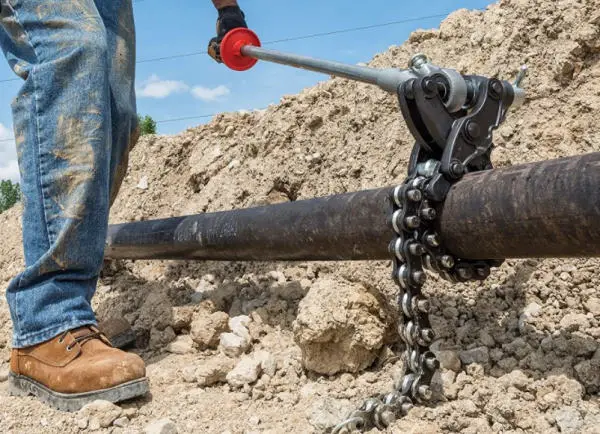
To plumbers, this is a popular method for cutting cast iron pipes. Here are the steps you should follow when using this tool:
- Clear the path to the cast iron pipe you are intending to cut and ensure that any leftover cables are not in the way.
- Place the cutter’s jaws either around or perpendicular to the pipe, ensuring that both of the cutter’s hooks are on it with its open side up.
- Pull the chain’s open-end tightly around the pipe, then slide the nearest chain pin inside the hook to secure it in place so you can start cutting.
- Ascertain the soil pipe cutter’s jaws are perpendicular to the pipe and the chain is aligned with the marked cutline.
- After securely fastening the chain to the cast iron pipe, tighten the power tool’s jaws by twisting the ratchet clockwise.
- As the pressure on the pipe increases, it will split cleanly as you forcefully rotate the ratchet.
FAQs (Frequently Asked Questions)
1. What is the best way to cut cast iron pipes?
The best way to cut cast iron pipes is working on a stable workbench and the pipes securely placed in a bench vise. You should choose reciprocating saws or soil pipe cutters for this cutting task, especially in tight places. However, if you don’t own either of them, the only safe alternative is angle grinders.
You can also use manual tools like a hacksaw or a ball-peen hammer and a cold chisel to cut through cast-iron pipes. However, they are not the best options for the job.
Hacksaws are inexpensive, but their blade is not strong enough for the toughness of cast iron. They are also the slowest and most labor-consuming method. Compared to hacksaws, a cold chisel can make this job a bit easier, but it requires a lot of skills and extra space to operate.
2. When should I replace the cast iron pipe?
If you find any leakage, this is the most telling indication that you should replace your cast iron pipes. Other signs include slow drainage, which is evidence of damaged seams, rust, or inner pipe corrosion.
3. What should I use to replace the cast iron pipe?
PVC pipes are most frequently used to replace worn cast iron pipes. They are also a better option for house plumping. The major reasons include the PVC’s higher durability, lower cost, and more lightweight than cast iron, which makes its installation easier.
4. How to replace cast iron pipes with PVC pipes?
To begin, remove any lead from your pipes, which enables the installation of a service brushing. By doing this, you can change your cast iron to PVC pipes without worrying about potential future leaks.
After that, join the PVC pipes together without using any glue/primer to find out whether there are problems that need to be addressed before the solution becomes permanent.
Finally, assemble stainless steel clamps and alternatively rubber couplings that you intend to use to complete the work. Next, finish your project by applying primer or glue.
Final Words
Reaching this point of the article, you have already got the hang of how to cut cast iron pipes with an angle grinder. Even though angle grinders are not suitable for cutting the pipes that are in hard-to-reach places like reciprocating saws or soil pipe cutters, they are still a safe alternative in other workspaces.
Besides the main cast iron cutting procedure, you should also pay attention to the preparation step to ensure that you can finish your task safely while using angle grinders or other power tools.
